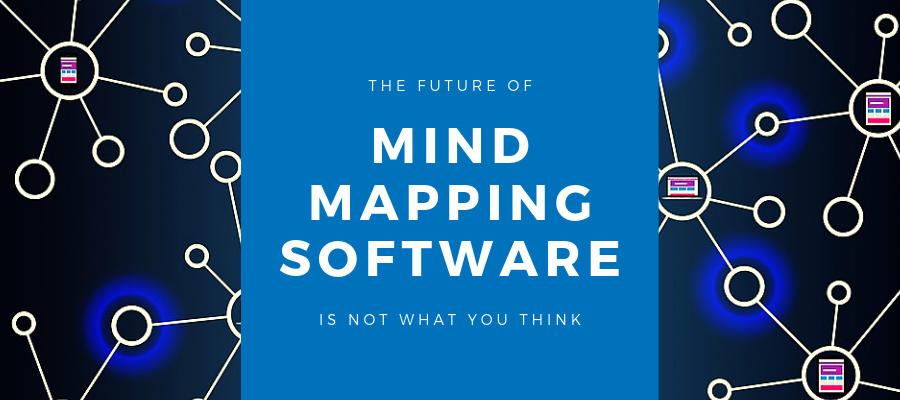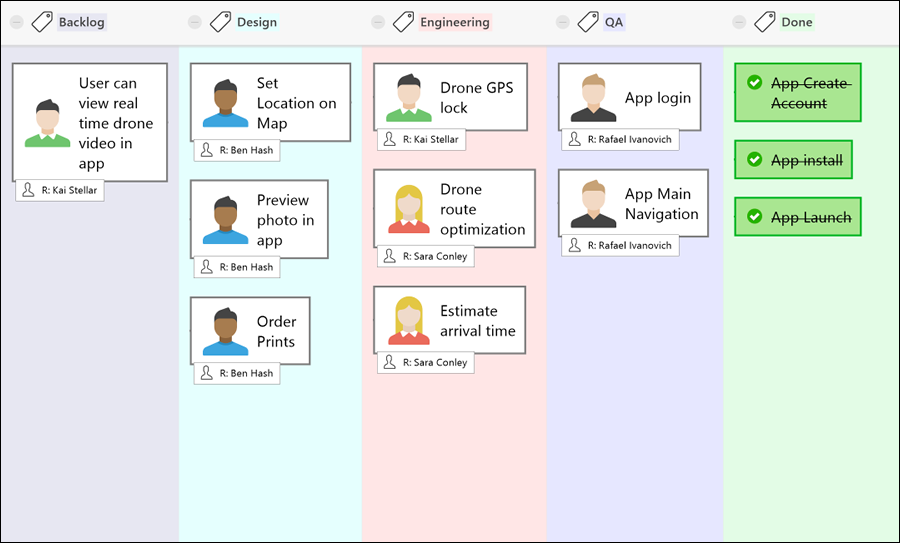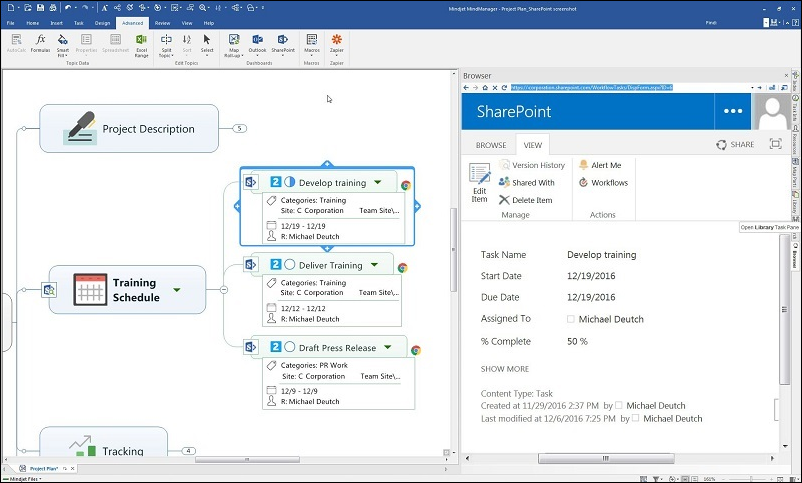
![]()
Mind mapping software is at a tipping point in how it allows users to present and work with data. There’s a choice between staying the course, or evolving into an entirely new type of business tool.
On the one hand, the mind mapping industry can continue focussing on the features that these platforms were originally famous for – facilitating creativity and brainstorming. On the other hand, there is an overwhelming business need for a solution that mind mapping software lends itself to better than any other platform: dynamic information visualization.
With the ever-growing rise of big data and digitalization across virtually all industries, mind mapping is well-positioned to lead the charge as the solution of choice for visualizing and working efficiently with vast quantities of information.
Many businesses have an overabundance of data and are struggling to find ways to centralize it, understand it holistically, and work with it in a way that improves their productivity. As the features and capabilities of mind mapping software evolve and become more powerful, visualizing and working with data comes more easily efficiently to companies using these platforms.
The future of our industry lies beyond mind maps. Instead, we are aiming to provide a work management solution for users to visualize and work with their data in whichever format works best for them. Before we dig more into what the future of mind mapping software looks like, let’s review how we got here as an industry in the first place.
A brief history of mind mapping
As many of the readers on this blog likely know, the term “mind mapping” dates back to the 1970s, when British psychology author Tony Buzan first used the phrase on BBC television. The use of diagrams to “map” information has been around for centuries, but it was at this time that the concept was labeled with a household name.
Mind maps were originally drawn on paper, chalkboards or whiteboards as a way to visually represent thought. Common use cases included brainstorming, studying, organizing information, problem-solving, decision making and writing. Mind mapping, as we know, is a powerful technique for unlocking ideas and thought processes.
Around the early 1990s, the rise of personal computers, mind mapping took on a digital form with the advent of purpose-built software. These platforms allowed users to create and manipulate robust mind mapping diagrams with ease. A digital interface enabled users to type, drag and drop information as quickly as they could think. It also enabled users to save their mind maps for later use, turning them into usable documents following a brainstorming session (something that whiteboards and post-it notes struggle to achieve).
As software and computers became more powerful, a wide variety of capabilities were added. These included templates for flow charts, diagrams, timelines and other use case-based visualizations. In addition, formatting, linking and dynamic information management features have started to enter the fold, allowing users to continuously use their mind maps as information dashboards, rather than stagnant documents.
This ability to dynamically capture and work with information in a visual way is where the leading mind mapping software is today, and where the industry as a whole is heading in the future.
Industry 4.0 and the rise of big data in business
As mind mapping software evolved, so too did many other data-capturing business platforms. Increasingly complex and powerful computer technologies have allowed companies to track and monitor a wide variety of different business-critical data points like never before. This amazing trend has evolved to the point that we, as a society, are on the verge of the next big inflection in industry.
The business world is on the cusp of what is being called the Fourth Industrial Revolution, or Industry 4.0. In this new frontier, virtually all business sectors can expect to see a sharp turn towards full digitalization and artificial intelligence-driven processes and data management. This has the potential to create unprecedented growth and enhanced productivity, provided the right tools are used.
Some of the industries poised to benefit the most from this shift to digitalization and information-driven business include:
- Production and manufacturing
- Finance and banking
- Insurance
- Healthcare
- Service industries
- Communications and marketing
- Sales
- Transportation
- Human resources
As each of these industries adopts new tools and platforms to track customer behavior and internal business operations, they can expect to be inundated with huge quantities of new and usable data. This leads to the question of how to deal with such large amounts of information in a way that benefits productivity.
Some key considerations for businesses in Industry 4.0 will be the following:
- How do we keep track of all of our data?
- How can we easily access it?
- How do we organize it so that we can easily understand which data is relevant to the task at hand?
- How do we make sure we can quickly and easily access and use our data to our advantage for daily operations?
- How can we ensure that our processes scale alongside an increase in data?
Without answers to these key questions, it’s possible that businesses will either not use their valuable data or, worse, it will hamper productivity due to information overload.
This is the interesting context that mind mapping software finds itself right now. As a tool specifically designed to visualize and manipulate data, mind mapping software is uniquely positioned to help companies become masters of their own information.
Some modern mind mapping software can act as a “visual front end” for big data. It enables you to consolidate your data, from all sources, into a single view.
The core benefits of this flexible visual centralization of data are:
- A more holistic view of all of your data in a single window.
- A better overall view of the context, significance and implications of data
- The reduction of data complexity with simple analysis features
- The ability to switch perspectives, allowing you to focus on only the most relevant data at the right time.
- Improved processes and knowledge management within your organization, through the continuous growth and evolution of your data without the need for new documents or platforms.
As a result of this centralization of data, mind mapping software users have a more simplified and improved understanding of what data they have, and how it relates to individual tasks and teammates.
Must-have information management features in mind mapping software
Over the years, leading mind mapping software developers have added a variety of powerful information management features that are used alongside the more traditional mind mapping software capabilities. Together, these features create a powerful data management tool that can be used in as basic or complex of a way as needed.
Some of these powerful information management features include:
Diagrams and views: Pre-built diagrams help users present and store data in different ways. Leading mind mapping software platforms offer diagrams that go beyond traditional templates, which can sometimes fall short when trying to visually represent large amounts of complex information.
Examples of these new diagrams types include flowcharts, swim lanes, concept maps, and background objects to create custom diagrams. The flexibility in map structure afforded by these new templates allows you to gather and present your company data in a way that best suits your needs.
Users can take this information visualization one step further in certain mind mapping platforms with a variety of different views and ways of presenting information. These can include maps, timelines, Gantt charts, Kanban boards, and so on. These views allow you to view your information in different ways, make better sense of it, and work with it in the best way possible. Users often find it amazing that simply viewing their data from a different perspective can uncover new and useful information.
Task information: Many mind mapping platforms also allow users to turn data into actionable tasks for projects, all within the same document. Users can assign specific roles, resources, deadlines and dependencies to map items. These capabilities add an actionable layer to your data, allowing you to transition from a stagnant document to a living one that can be used to manage large or small projects.
Tag and filter: Because of the amount of data that can be stored and worked within a mind map, functionality has been added to some tools that allows users to tag their data with a variety of different markers. This allows users to group similar pieces of data, or section it in whichever way they want.
Using dynamic filtering capabilities, users can then filter out or highlight large chunks of data that they have tagged. This is a powerful and dynamic information visualization feature that allows users to zero in on only the data that is most important at a given time, retrieve specific information and reduce complexity.
Hyperlinks: Going beyond the traditional mind mapping technique of inputting data manually, the hyperlinking capabilities found in modern tools allow you to link in web pages, emails, folders, files or database information, either locally or from the web.
Hyperlinks are a game-changer for information management because they let you pull exterior information into your core mind map file. Centralize your data, access it easily via hyperlinks, and dynamically work with it in whichever way you need to.
Integrations: To further this ability to pull data from a variety of sources, many mind mapping platforms also included integrations with popular business platforms such as SharePoint, Outlook, Word, and Excel. This, along with hyperlinks, allows users to aggregate all of their most important business data into one, centralized location. Lots of information is stored in emails and Microsoft documents, which is difficult to aggregate and view holistically.
Hyperlinking and integrations coupled with mind mapping’s dynamic information functionalities enable users to process and work with their data visually in a way that is simply not possible when left in the original platform. Picture your information, presented visually and linked to from a single, easy-to-access location. No switching between applications, and no digging around for important files.
With integrations and hyperlinking, users can call on detailed information from their databases when needed. Rather than pulling in massive amounts of data, users can simply link to and open files directly within their mind map file. This creates an incredibly in-depth but simple information platform that can be used to manage your information visually.
Topic properties and calculations: Modern mind mapping software offers a wide variety of ways to work with your data, make calculations, sort on file properties, and so on. A powerful way to do this is by including the metadata as part of your map topics. Metadata can include the file creation data, file size, original location, file type, creator and so on. By layering metadata onto your map topics, and using the tagging, filtering and formatting functionalities, users have access to very powerful tools for analyzing and grouping their information visually.
Secondly, some mind mapping tools offer the ability to add calculations and formulas to your map data. For example, if part of your map contains financial information, you can dynamically add calculations that show you the impact of a variety of different action items. By applying calculations to different layers of data, you can see the cause and effect of your decisions.
Dynamic formatting: The last, and perhaps most powerful, feature in mind mapping software today is dynamic formatting. This working with information to the next level, providing full automation for your workflows, processes and tasks. By applying dynamic formatting to different parts of your data or map structure, you can automatically trigger changes to the actual topic information, such as topic icons, tags, properties or task information.
This turns your visualized information dashboard into a living, breathing, and working document that you can use to make decisions about your workflows and tasks. Dynamic formatting can even be used to automatically update the data living in all sources of information linked to your map, eliminating the need to manually update your files.
Each of the functions outlined above allow users to dynamically and visually work with their data. Today’s software has moved from mere mind mapping tools to a platform for full data visualization.
As the technology available to companies to collect data becomes more and more complex, the need for an easy and reliable platform to visualize and work with that information becomes ever more critical.
Mind mapping software is at a crossroads: stay the course, or expand into a platform that’s purposefully built to deal with these game-changing problems.
Blair Young is Senior Director of Products for MindManager, a division of Corel Corporation. In this role, Blair is responsible for product management, product marketing and strategy for MindManager, an industry leader for data visualization, planning, manipulation and actioning. Blair brings over 30 years of global product management and product marketing experience in the enterprise, prosumer and consumer markets. These include cybersecurity, SaaS, business efficiency, big data, mobile, data visualization, AI, telephony and data communications. He holds a Masters in Computing Sciences specializing in artificial intelligence from the Technical University of Nova Scotia (now part of Dalhousie University).




Leave a Reply